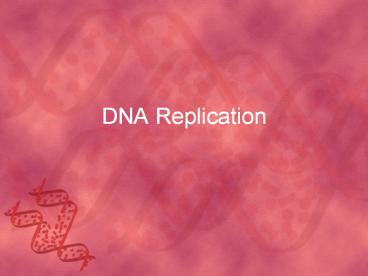DNA Replication - PowerPoint PPT Presentation
1 / 12
Title:
DNA Replication
Description:
DNA Replication When does DNA replication happen during the cell cycle? The S phase In order to go through cell division we must have two copies of DNA The process of ... – PowerPoint PPT presentation
Number of Views:142
Avg rating:3.0/5.0
Title: DNA Replication
1
DNA Replication
2
- When does DNA replication happen during the cell
cycle?
- The S phase
- In order to go through cell division we must have
two copies of DNA - The process of replication assures that each new
cell made has a complete set of identical genetic
information. - With out replication, our cells would not be able
to perform their function correctly
3
- Are the two strands of DNA considered to be
complementary to one another?
- YEP! Since A binds with T and C binds with G,
they are always opposite one another. - Meaning if one side is ACACACAC then the other
strand is TGTGTGTG. - Being complementary to one another allows each
strand to serve as a TEMPLATE for a new strand! - This characteristic is important for the process
of replication.
5
3
5
3
4
- What does the 5 and 3 mean on the DNA strands?
- Because DNA strands are complementary (opposite
one another) we have to be able to determine the
top from the bottom. - This is done by marking it as a 5 prime or 3
prime end. - This also helps determine the direction of
replication on the DNA strand - Replication ALWAYS starts at the 5 prime end
5
3
3
5
5
Steps to DNA Replication
- Replication can be studied as 3 steps
- (although all occur simultaneously in the cell)
- Although people may say that DNA copies itself,
the DNA itself does nothing more than store
information. - Enzymes and other proteins do the actual work of
replication - Helicase starts the process by unzipping the
double helix to separate the strands - DNA polymerase bonds new nucleotides together
6
Step 1
- The enzyme Helicase begin to unzip the double
helix at numerous places along the chromosome - That is Hydrogen bonds that connect the base
pairs are broken
7
Step 1
- As the strands separate, the bases on each strand
are exposed for the next step (happening
simultaneously) - Unlike unzipping a jacket, replication proceeds
in two directions at the same time.
8
Step 2
- DNA polymerase, another enzyme, creates the
daughter strands by adding complementary bases to
the parent strands (which act as a template).
9
Step 3
- The two developing DNA strands separate into two
new, identical daughter strands and DNA
polymerase proofreads them. - (Label the parts below on your notes)
Original Strand
New Strand
New Strand
Original Strand
10
Replication is fast and accurate.
- DNA replication starts at many points in
eukaryotic chromosomes.
- DNA polymerases can find and correct errors.
11
- In every living thing, DNA replication happens
over and over again, and it happens remarkably
fast. - In humans, about 50 nucleotides are added every
second to a new strand of DNA - Your DNA has replicated trillions of times since
you grew from a single cell. - http//www.youtube.com/watch?velINXJZr3FE
12
Real Picture of DNA replication































